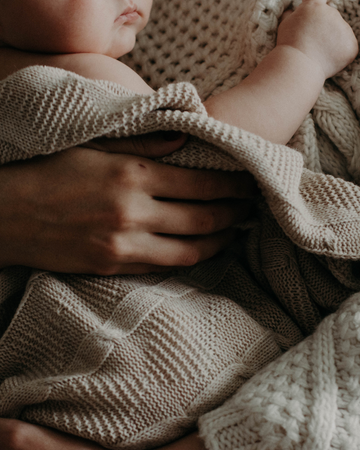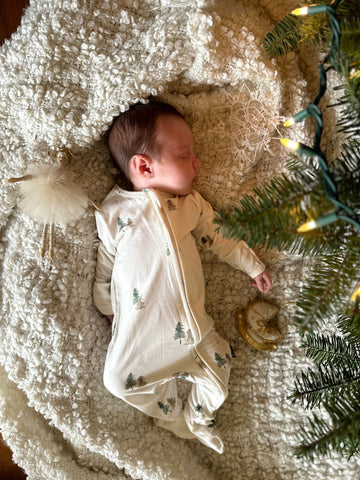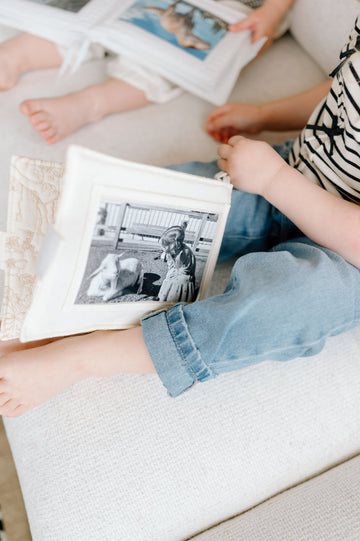Choosing the right fabric for your baby or child's clothing and accessories isn’t just about style—it’s about health, comfort, safety, and sustainability. With growing awareness around chemical exposure, ethical manufacturing, and environmental impact, many parents are asking: What fabrics are truly safe for children?
This guide breaks down the most common fabrics used in children’s clothing and textiles, sharing the pros, cons, safety concerns, and expert-backed guidance to help you make confident choices.
1. Cotton (Conventional and Organic)
Pros:
- Soft, breathable, and gentle on sensitive skin
- Highly absorbent (great for drool and spills)
- Affordable and widely available
Cons:
- Conventional cotton is one of the most pesticide-intensive crops in the world
- Heavily water-intensive to produce
Best Choice: Organic Cotton
Grown without toxic pesticides or fertilizers, organic cotton is a safer choice.
According to the Environmental Working Group (EWG), “Children are especially vulnerable to pesticide exposure due to their developing bodies and immune systems.”
Developmental Benefits:
Breathable fabrics like cotton reduce skin irritation and help regulate body temperature, promoting better sleep and calm behavior in infants.
Look for: GOTS (Global Organic Textile Standard) certification for verified organic and ethical practices.
2. TENCEL™ (Lyocell)
Pros:
- Silky soft and breathable
- Made from sustainably sourced eucalyptus wood
- Closed-loop production process recycles 99% of water and solvents
- Antibacterial and moisture-wicking (great for eczema-prone skin)
Cons:
- Slightly more expensive than cotton
- May not be as durable over years of heavy use
Expert Insight:
“TENCEL™ is one of the most sustainable and skin-friendly fabrics available. Its smooth fiber surface makes it ideal for sensitive baby skin,” says Dr. Anna Scott, pediatric dermatologist at Toronto Children's Health.
Safety Note:
TENCEL is Oeko-Tex Standard 100 certified, meaning it’s been tested for harmful substances. It’s often regarded as a safer alternative to bamboo rayon, which we’ll cover next.
3. Bamboo Rayon / Viscose
Pros:
- Ultra-soft and stretchy
Cons:
- Misleading marketing: bamboo fabrics are often chemically processed into rayon using toxic solvents like carbon disulfide
- Not environmentally friendly despite “eco” branding
- May retain residues harmful to babies
Health Warning:
The Federal Trade Commission (FTC) warns:
“Bamboo fabrics advertised as ‘natural’ or ‘chemical-free’ are often rayon produced with toxic solvents, misleading the public.”
A Note for Parents:
Bamboo rayon has been linked to adverse reactions in some infants. Even Oeko-Tex certification doesn’t guarantee that the chemical thresholds are safe for babies, as those limits are set for adult use, not infant ingestion or skin absorption.
4. Merino Wool
Pros:
- Thermoregulating: warm in winter, cool in summer
- Naturally antibacterial and odor-resistant
- Great for layering and outdoor gear
Cons:
- Can be itchy if not ultra-fine (look for 17.5 microns or less)
- Expensive
- Requires gentle washing or dry cleaning
Good to Know:
Merino is naturally flame-resistant and doesn’t require added chemicals to meet safety standards, unlike synthetic pajamas.
Ideal Use:
Sleepwear, base layers, or cozy outerwear for toddlers and older babies. Always check for mulesing-free labels to ensure ethical treatment of sheep.
5. Polyester and Other Synthetics
Pros:
- Durable, wrinkle-resistant
- Often inexpensive and quick-drying
Cons:
- Non-breathable: traps heat and moisture, which can irritate skin
- Often treated with flame retardants and other chemicals
- Made from petroleum, contributing to microplastic pollution
Flame Retardants Warning:
According to The American Academy of Pediatrics:
“Flame retardant chemicals commonly found in children's sleepwear have been associated with hormone disruption, learning problems, and increased cancer risk.”
Bottom Line:
Avoid polyester sleepwear and clothing labeled "flame resistant." Instead, opt for natural fibers like wool or snug-fitting cotton that meet safety regulations without chemical treatment.
6. Linen
Pros:
- Strong, breathable, and naturally hypoallergenic
- Sustainable: requires less water and pesticides than cotton
- Becomes softer with each wash
Cons:
- Can feel rough at first
- Wrinkles easily (not ideal for all parents)
Great For:
Summer clothing, toddler dresses, or nursery bedding. Best used when softened through natural washing or stone-washing.
What About Finishes?
Even if you choose a safe base fabric, chemical dyes, finishes, and treatments can pose risks.
Avoid:
- “Easy care,” “wrinkle-free,” or “stain-resistant” claims (often involve formaldehyde)
- Synthetics known to be irritants or allergens
Look for:
- Oeko-Tex® Standard 100 certification
- GOTS-certified
- Brands that disclose full supply chain and dye processes
Quick Comparison Chart
| Fabric | Pros | Cons | Best Uses |
|---|---|---|---|
| Organic Cotton | Safe, breathable, affordable | Not as durable as some blends | Everyday clothing, swaddles |
| TENCEL™ | Sustainable, soft, antimicrobial | Expensive, less durable over time | Pajamas, onesies, blankets |
| Bamboo Rayon | Soft, stretchy | Chemically processed, potential residue | Not recommended for babies |
| Merino Wool | Warm, breathable, antimicrobial | Costly, may need special care | Base layers, outdoor wear |
| Linen | Durable, breathable, sustainable | Wrinkles easily, may feel stiff initially | Summer clothing, nursery bedding |
| Polyester | Cheap, durable, fast-drying | Not breathable, chemical-laden | Avoid for infants; OK for older kids’ outerwear if no safer option |
Final Thoughts: What Should Parents Choose?
If you’re feeling overwhelmed, start with these guidelines:
- Choose natural, breathable fabrics like organic cotton, TENCEL™, and merino wool
- Avoid flame-retardant-treated synthetics and bamboo rayon
- Look for trusted third-party certifications (GOTS, Oeko-Tex®)
- Prioritize safety over softness
Bonus for Parents
At The Cotton Lane, we’re committed to doing the homework for you. We're actively researching the ever-evolving world of fabrics, child safety, toy regulations, and early development—because what touches your child matters.
We don’t follow fads or trends. We focus on science-backed information and long-term safety to help parents make confident, informed choices.
Join our newsletter to keep learning alongside us. You'll receive free weekly printables, memory-making ideas, and early access to our thoughtfully designed, family-focused products.
References
- Environmental Working Group (EWG). “Children and Pesticide Exposure.”
- Federal Trade Commission (FTC). “How to Avoid False Claims About Bamboo Textiles.”
- American Academy of Pediatrics. “Flame Retardant Chemicals and Children’s Health.”
- TENCEL™ by Lenzing. "What Makes TENCEL™ Fibers Sustainable?"
- GOTS: Global Organic Textile Standard. www.global-standard.org
- Oeko-Tex® Association. “Confidence in Textiles.” www.oeko-tex.com




